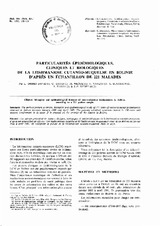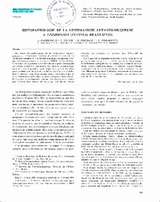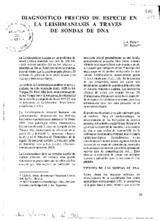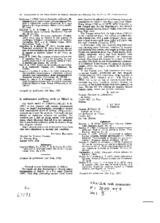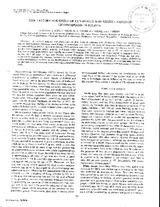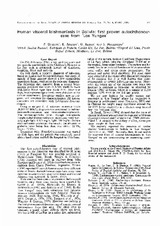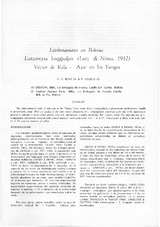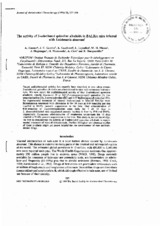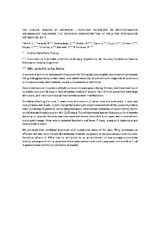Buscar
Mostrando ítems 1-10 de 15
Particularités épidémiologiquez, cliniques et biologigues de la Leishmaniose cutanéo-muqueuse en Bolivia d'après un échantillon de 221 malades
(Bull. Soc. Path Ex., 1993)
Résumé. Les auteurs présentent les aspects cliniques, biologiquez et épidémiologigues de la leishmaniose cutanéo-muqueuse, d’après un échantillon de 221 cas (136 leishmanioses cutanées et 85 leishmanioses muqueuses) observés ...
Histopathologie de la Leishmaniose cutanéo-muqueuse a Leishmania (Viannia) braziliensis
(Ann. Dermatol. Venereol., 1994)
Résumé.
Une étude histopathologique de la leishmaniose cutanéo-muqueuse à Leishmania (Viannia) braziliensis est réalisée sur 28 biopsies cutanées et 114 biopsies muqueuses de patients d'origine bolivienne et péruvienne, ...
Diagnóstico preciso de especie en la Leishmaniasis a través de sondas de DNA
(Salud Boliviana, 1988)
La Leishmaniasis humana es un problema de salud pública mundial con más de 400.000 casos nuevos anuales (1) en los trópicos y subtrópicos, No se tienen prevalencias exactas, pero se estima que la Leishmaniasis afecta a 20 ...
Visceral canine leishmaniasis in Bolivia
(Transantions of The Royal Society of Tropical Medicine and Hygiene, 1982-05-11)
We report the first description ofr visceral canine leishmaniasis in Bolivia. In a first stage (October 1980), three dogs presenting mucous nasal lesions were found to be infected with Leishmania (numerous amastigotes on ...
Risk factors for onset of cutaneous and mucocutaneous Leishmaniasis in Bolivia
(American Journal Tropical Medicine and Hygiene, 1997)
Abstract.
A survival analysis was performed on data from an endemic area of Bolivia where two populations, natives and highland migrants, were living, to investigate risk factors for onset of cutaneous leishmaniasis (CL) ...
Human visceral leishmaniasis in Bolivia : first proven autochthonous case from "Los Yungas"
(Transactions of The Royal Society of Tropical Medicine and Hygiene, 1983)
On 25th February, 1982, a boy aged two years and two months was brought to the Children's Hospital in La Paz with a six-month history of diarrhoea, vomiting, fever and asthenia. On 14th April, a tentative diagnosis of ...
Leishmaniasis en Bolivia : Lutzomyia longipalpis (Lutz & Neiva, 1912) Vector de Kala - azar en los Yungas
(Instituto Boliviano de Biología de Altura, 1983)
Summary.
The epidemiological study of kala-azar in the "Yungas" focus shows that L. longipalpis, a predominant phlebotomine sandfly in peridomestic areas (96% of catches) is the main vector, Dissections of L. longipalpis ...
The activity of 2-substituted quinoline alkaloids in BALB/c mice infected with Leishmanis donovani
(Journal of Antimicrobial Chemotherapy, 1994)
Abstract.
Potent antileishmanial activity has recently been described in vivo when certain 2-substituted quinoline alkaloids are administered to mice with cutaneous leishmaniasis. We now report the ahtileishmanial activity ...
Clinical healing of antimony-resistant cutaneous or mucocutaneous Leishmaniasis following the combined administration of interferon-γ and pentavalent antimonials compounds
(Transactions of The Royal Society of Tropical Medicine and Hygiene, 1994)
Abstract.
In an open trial, longer courses of pentavalent antimonials (Sbˇ) at sub-optimal doses (10 mg/kg body weight), in association with recombinant human interferon-γ (IFN-γ) (100 µg/m2 of body surface area) were ...

